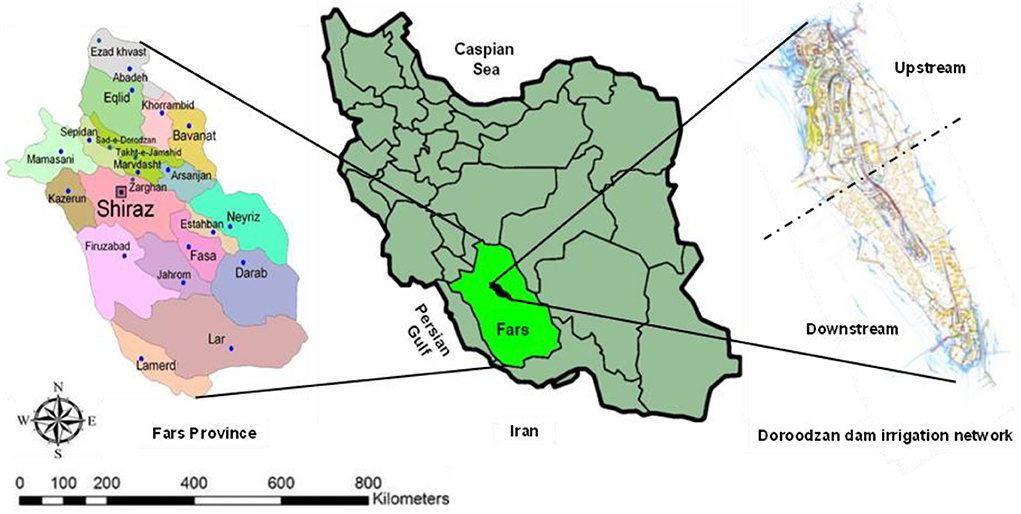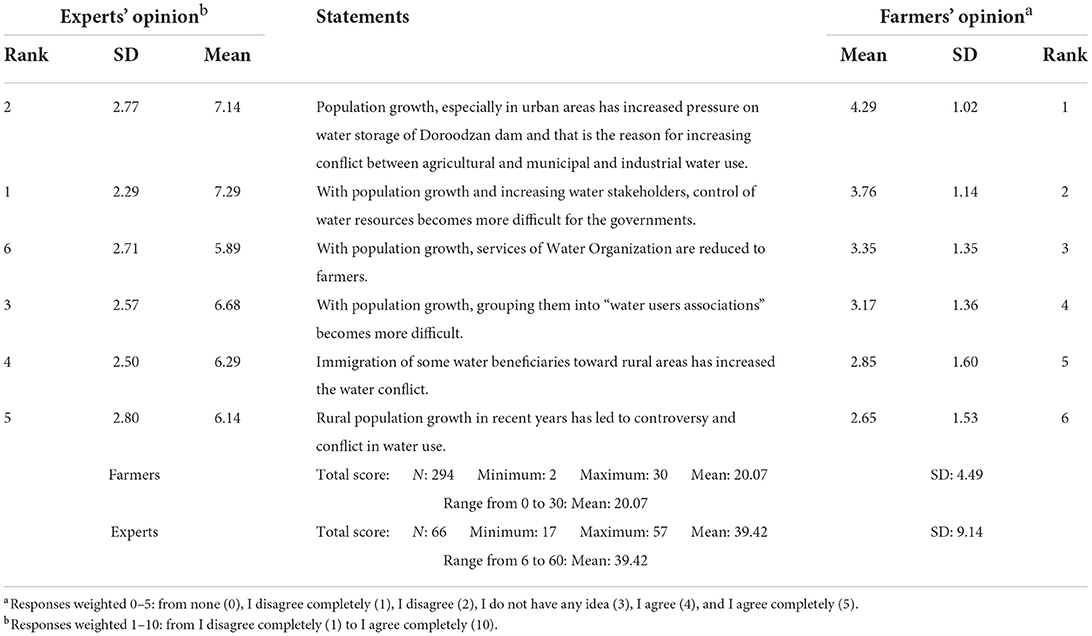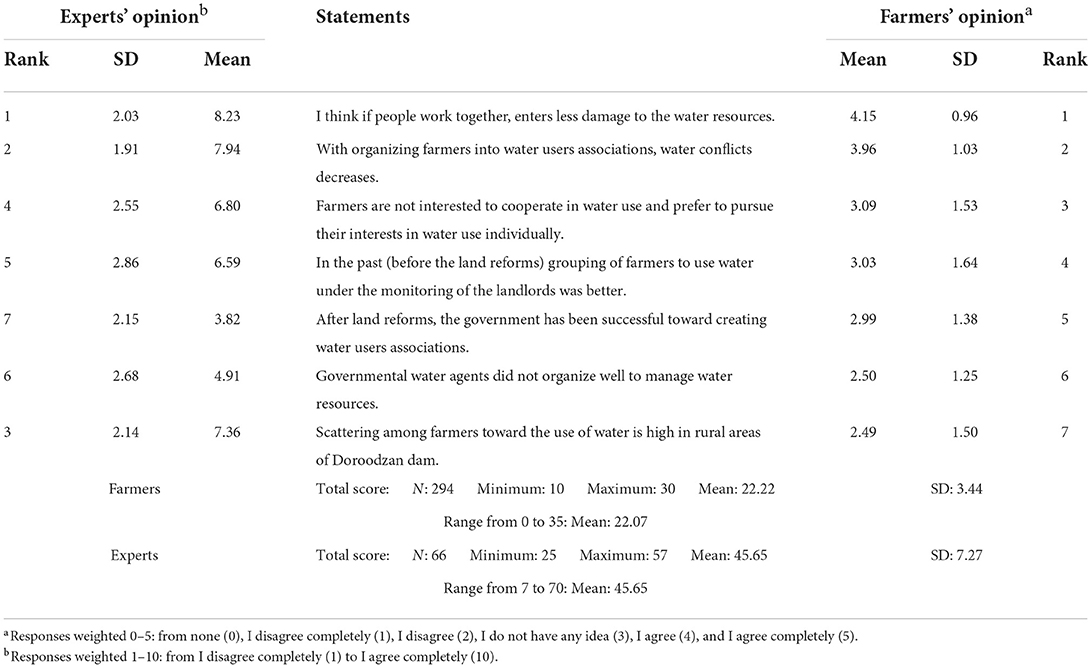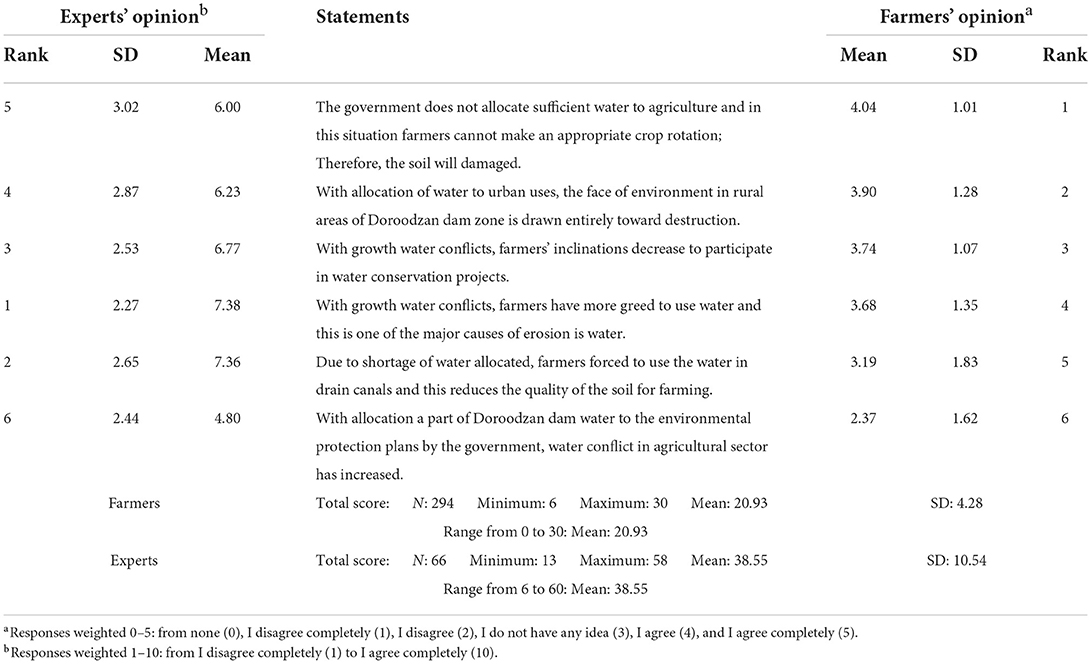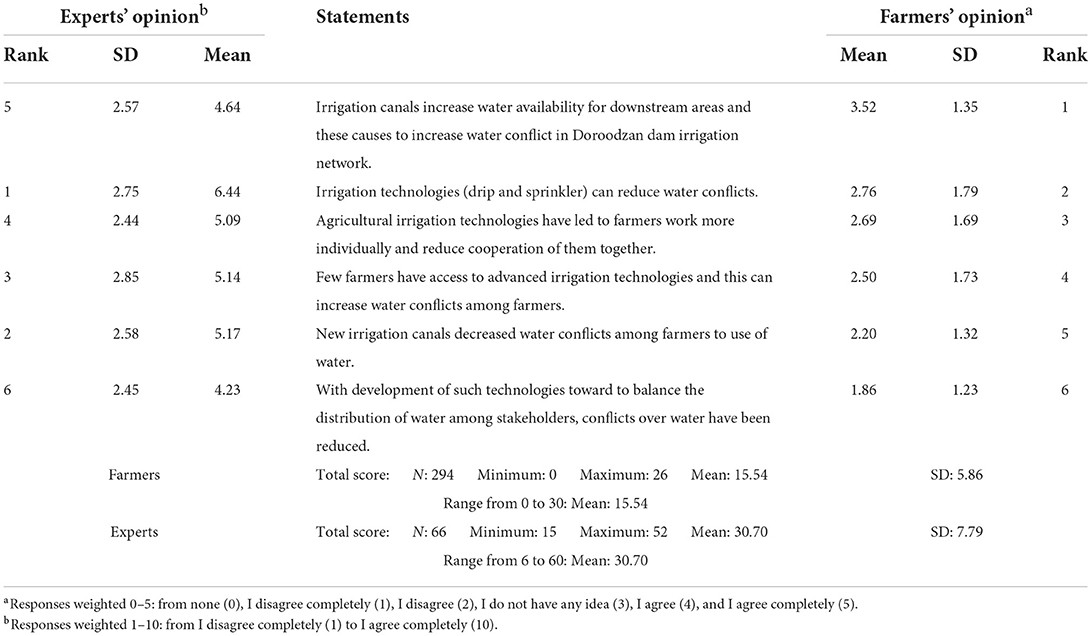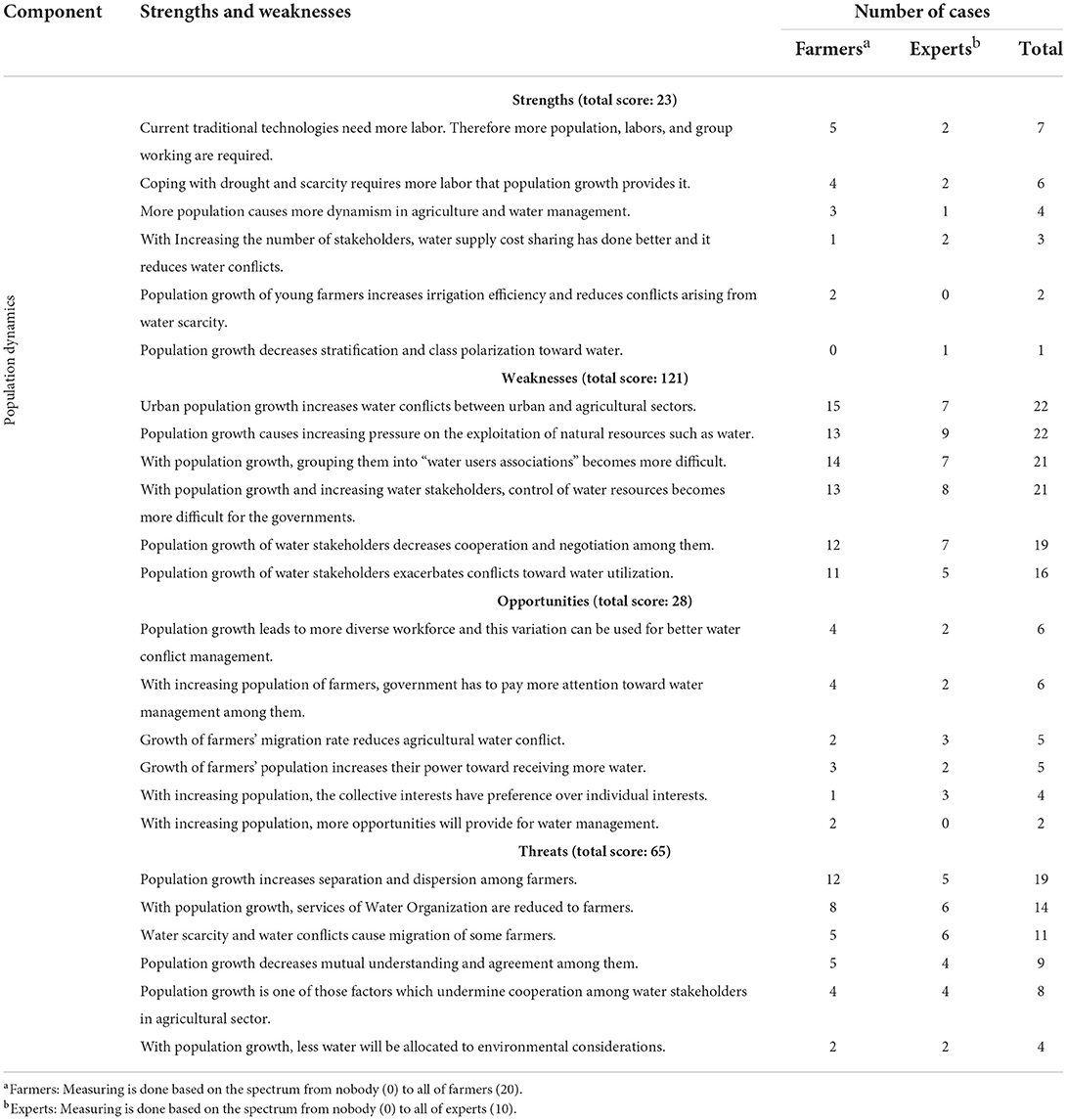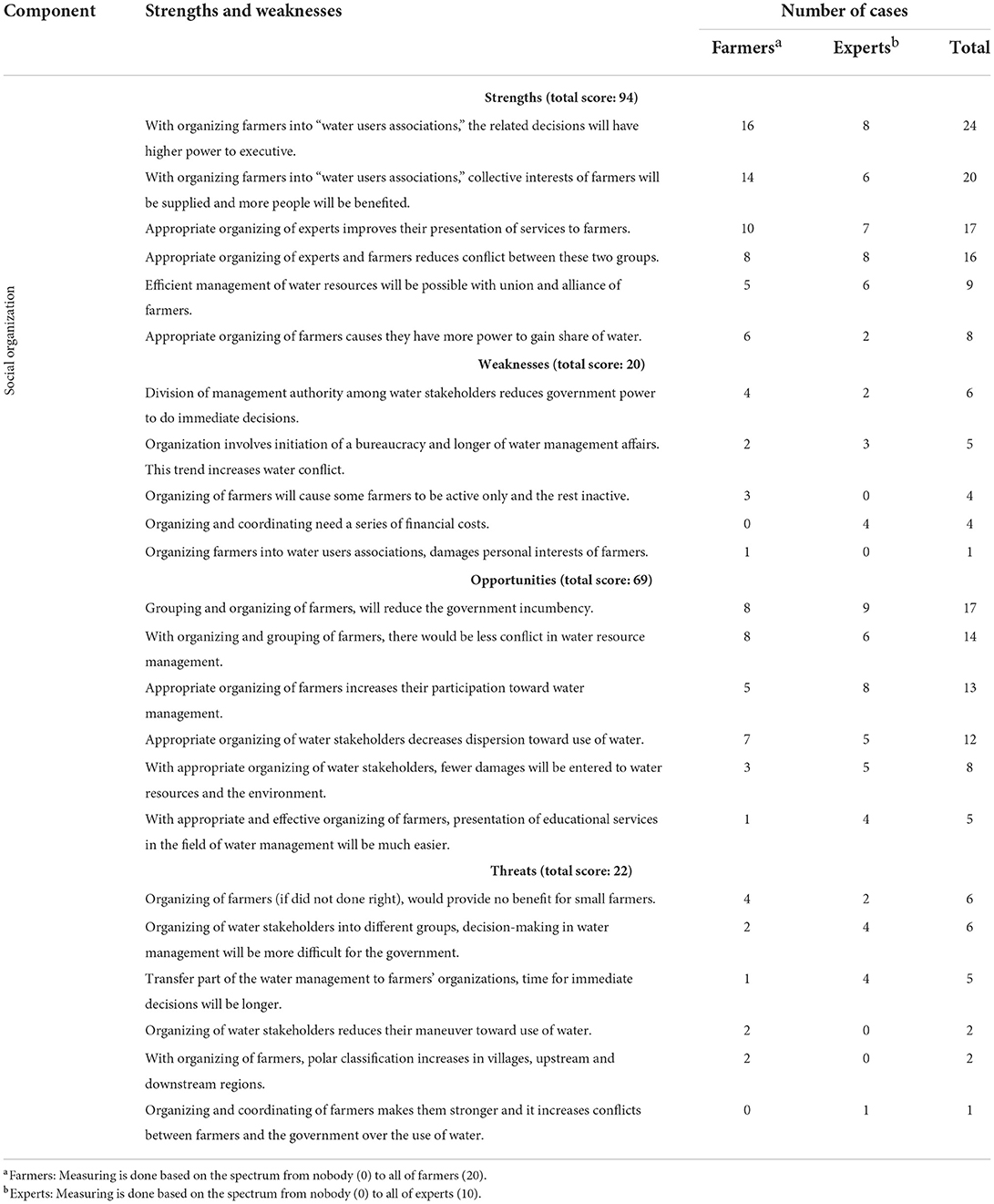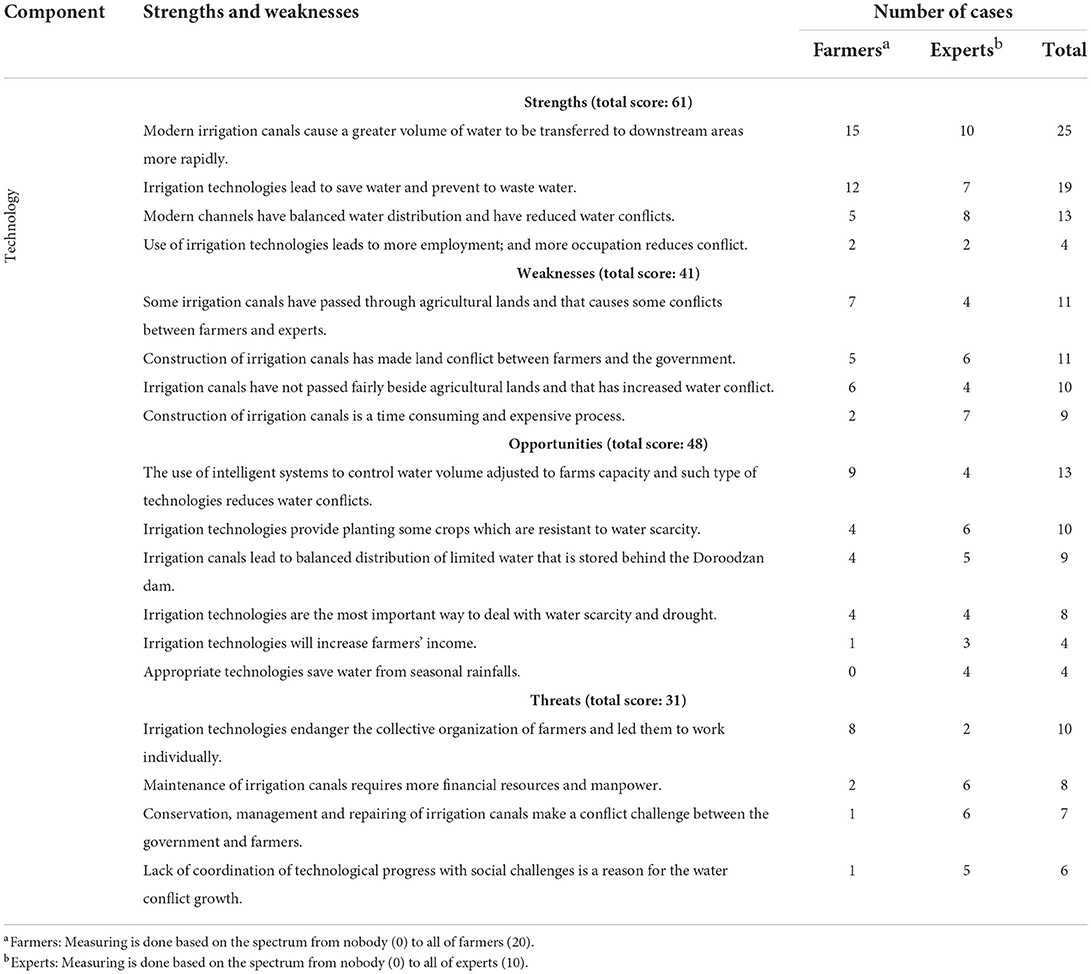- 1Department of Agricultural Extension and Education, College of Agriculture, Tarbiat Modares University (TMU), Tehran, Iran
- 2Department of Agricultural Extension and Education, School of Agriculture, Shiraz University, Shiraz, Iran
- 3Department of Technology Development Studies (DTDS), Iranian Research Organization for Science and Technology (IROST), Tehran, Iran
Water conflicts might be a serious threat for the life quality of stakeholders and also an obstacle on the way of human and environmental development. Obviously, the environment could be affected by such conflicts. The purpose of this study was to investigate the agricultural water conflicts through a human ecological perspective using POET model and SWOT analysis. A descriptive mixed method including two surveys and semi-structured interviews was fulfilled as a research method. The study was conducted in Doroodzan dam irrigation network in Fars Province, Iran. The statistical population of this study included two groups of farmers and regional water experts; besides, the research tools included two questionnaires and semi-structured interviews. SWOT findings revealed that the best strategies reducing and controlling agricultural water conflict, and also maintaining and enhancing the environmental sustainability, are adaptation of participatory water management approaches, formation and strengthening of water user associations, and conformity of irrigation technologies with farmers' circumstances.
Introduction
The global population growth and life style changes have caused a greater level of water conflicts and also a heightened demand for water. The increase of quality and quantity issues exacerbate health problems, environmental degradation, and resource competition (Houdret et al., 2006); in fact, the rapid development of social economy has caused sustained pressures on natural water resource systems, which led to severe consequences, and one of the mentioned consequences would be the increase of frequent and fierce water conflict. Water conflict has been a universal phenomenon. According to the UN World Water Development Report, water problems induced 1,831 great conflict events in the world in the past 50 years, among which 21 events had been evolved into military conflicts (Zhang, 2004; Wenjuan et al., 2009).
Water conflict is a term describing a type of conflict among countries, states, or groups over an access to water resources (Wolf et al., 1999; Kameri-Mbote, 2007; Tulloch, 2009). Water conflict is related to the situations of incompatible or adverse interests among water users over modes of access, and resource quantity and quality (Houdret et al., 2006). The UN has recognized that water disputes generally result from opposing interests of water users, being public or private (United Nations, 2008). Water-related conflicts are conflicts arising between two or more parties holding competing claims over a water resource, its allocation, or its use (OECD, 2005). Water conflict situations in agriculture are considered as real conflicts when one stakeholder begins to act in favor of his interests whereas it is seen as a threatening or aggressive act by the other actor(s) (Knierim and Nagel, 2001). “Water conflict in this study is limited to local conflicts in agricultural sector in terms of using fresh surface water.”
In 1995, Ismail Serageldin, vice-president of the World Bank, said “many of the wars of this century were about oil, but wars of the next century will be about water” (Knierim and Nagel, 2001). In a similar vein, in 2000, UN secretary general, Kofi Annan, suggested that “fierce competition for freshwater may well become a source of conflict and war in the future” (Ravnborg, 2004).
Global water use has been almost tripled in the second half of the twentieth century, which shows an increase being much faster than the world's population in that same period time. Water recourses are used for different human activities, broadly divided among agriculture (70%), industry (22%), and domestic use (8%); these competing uses of freshwater frequently cause conflicts (Gehrig and Rogers, 2009).
In Iran, the greatest amount of water (94.25%) is being used by agricultural sector. Of this amount, about 50% is exploited from surface water resources, and another 50% from groundwater (Ardekanian, 2003). Besides, over 80% of water is wasted, the main reason of which is a lack of advanced; that is not using advanced irrigation technologies (Beheshtinejad, 2009). One of the aspects of this mismanagement is about conflict management among water stakeholders. So, the appropriate management of water resources in the agricultural sector would be very important.
Water conflicts, water scarcity, access inequality, and use and decision about water, might be the serious threats for the life quality of stakeholders and also obstacles on the way of human and environmental development. It is clear that environment can be affected by these conflicts.
Water conflict in Iran's agricultural sector is growing strongly either. Agricultural water conflicts in this country show that there are different goals among stakeholders particularly farmers and the government. Since regional water experts as government officials are responsible for water management, it is important to assess their views about water conflicts. Also, investigation of farmers' opinion (as the most important water stakeholders in the agricultural sector) and comparing that with regional water experts' opinion especially in related to environment would provide useful results to manage agricultural water conflicts.
Government is presently considered as the manager of water recourses in Iran. It controls and distributes water among stakeholders. In this way, the government is the owner and the controller of water in all dimensions and water stakeholders have no important roles in this management. The government holds all responsibilities and farmers are merely users.
In reply to why water conflict is a crisis in agricultural sector in Iran, we must focus on the evolutional trend of water conflicts in the using of water resources in agriculture. There are three turning points in this trend (Bijani and Hayati, 2011).
1. Before land reform (Latent water conflict: before 1963):
Before land reform in Iran, landlords were known as the owners of agricultural water resources. They were manager of water and controlled consumption and distribution of water. Landlords that named masters were persons who had a lot of lands and water resources as two key components of agricultural production. Consumption and distribution of water was controlled by them under a specific discipline. Therefore, there was no particular water conflict in that period.
2. After land reform up to political revolution of Iran (The start of water conflict: 1963–1979):
After land reform, landlords became weak and the system of master and peasant was overthrown. In the continuation of land reform, water was recorded as national resource. Government was known as responsible of control and managing of water in agricultural sector. Government was assigned to administrate distribution of water among stakeholders. In that way, some rules were registered for better control of water distribution. Forcefully, are admitted the start of agricultural water conflicts is from this point, because the government had no control and surrounding on water resources such as landlords. For example, unauthorized revenue from water resources increased after land reform. Also, digging of deep wells developed. We can say in this period not only the government had no enough power to control water conflict, but also that was a factor of creation conflict between itself and stakeholders.
3. After political revolution up to now (Culmination of water conflict: after 1979):
After political revolution in 1979, the government decreased its control over water resources. In that condition, there was no needed anticipation and legal mechanism for controlling water conflicts. Furthermore, in the last decade, another important factor added to this trend and increased water conflicts in agricultural sector. In fact, this factor was weather changes especially drought. With the condition of drought and water scarcity, managing water conflict is more complex. The main part of conflict there is between government and stakeholders especially in districts that are confronting with drought. On the other side, urban and industrial consuming has had a large growth in the recent years and government allocates the most of saving water to them. It is one of the reasons of conflict between government and stakeholders.
The purpose of this study was to investigate agricultural water conflicts through a human ecological perspective using POET model and SWOT analysis.
Theoretical literature review
Environmental sociology is the study of the reciprocal interactions among the physical environment, social organization, and social behavior. Within this approach, environment encompasses all physical and material bases of life in a scale ranging from the most microlevel to the biosphere. The development of human ecological studies could be very helpful in this regard. Nowadays, most arguments over natural resources and environment are mainly focused on human. In human life equations, focusing on the relationship between human and environment is an important factor. In this way, one of the most important sections is focusing on conflict studies on using and managing natural resources such as water among beneficiaries. One of the most important points of water conflict in agricultural sector in Iran is linked to the lack of sufficient attention to this subject; in fact, considering human as the mere consumer and user is a big mistake, which is common in using fresh waters resources.
In 1978, Dunlap and Van Liere proposed the emergence of a New Environmental Paradigm (NEP); thus, they developed a 12-question scale to determine whether people were embracing the NEP or holding to the traditional Dominant Social Paradigm (DSP) beliefs. In this way, the NEP could measure whether a shift away from the DSP was occurring as predicted by Dunlap and Van Liere (Wolters, 2012).
The New Ecological Paradigm (NEP) has been a widely used, effective tool for measuring ecological values that can lend valuable insight into whether values impact knowledge and the subsequent behavior related to that knowledge. It is uncertain to what degree belief in the NEP correlates with environmental behavior (Wolters, 2012). In this NEP view, human dominance, argued to be more adaptable than biological traits, was felt to be justified by the uniqueness of culture; besides, making it capable of solving all natural problems, culture has the capacity to accumulate and innovate. Therefore, as humans were not conceived of being governed by natural conditions, they were felt to have a great control of their own destiny. Using human ingenuity, any potential limitation posed by the natural world was felt to be surpassed. Research proceeded accordingly without environmental analysis (Dunlap et al., 2000).
New Ecological Paradigm recognizes the innovative capacity of humans, but states that humans are yet ecologically interdependent as with other species (Green, 2002; Harper, 2004). According to NEP, whereas humans have exceptional characteristics (culture, technology, etc.), they remain one among many species that are interpedently involved in the global ecosystem. NEP human affaires are influenced not only by social and cultural factors, but also by intricate linkages of cause, effect, and feedback in the web of nature; thus purposive human actions have many unintended consequences. NEP humans live in and are dependent upon a finite biophysical environment, which imposes potent physical and biological restrains on human affairs. Although the invectiveness of humans and the powers derived from there may seem for a while to extend carrying capacity limits, ecological laws cannot be repealed (Hayati and Rezaei-Moghaddam, 2006).
Namboodiri (1988) stated that the human ecological approach is a powerful perspective in the analysis of power relations and conflict processes. To organize an attempt for determining how key variables affect the likelihood of conflicts over natural resources, the human ecology approach is applied throughout this study.
Water is a valuable resource, which frequently crosses political borders; the right to exploit water resources has been often disputing. The literature on this subject has extensively speculated on the causes of international and interior national water disputes (Green, 2002).
Since the 1960's, human ecologists and other environmental social scientists have stressed the importance of the interactions between nature and society. Recently, some of these environmentalists have posited that the deterioration of natural systems such as water, air, and soil, could have negative effects on social, political, and ecological securities (Bijani et al., 2017). While there is a legitimate, ongoing debate over whether economic and technological development would solve the disputes that occur over natural resources, and when studying the causes of natural resource conflicts, there have been several reasons for why the ecological approach is a useful theoretical approach (Green, 2002).
A consistent body of academic material denies the causal relation between natural resources scarcity and the armed conflict, as Gleditsch (1998) mentioned before. This is a subject that several authors have revealed their special area of interest over that. Thomas Homer-Dixon in several titles has developed his concept of “ingenuity” in relation to the outbreak of conflict emanating from a perceived or real resource scarcity; Likewise, Leif Ohlsson has developed his thinking on the connection between conflicts and resource scarcity in a number of titles. There have been few studies based on the large amounts of data that have persuasively proved the correlation between scarcity (or perceived scarcity) of natural resources and violent conflict. Hauge and Ellingsen conclude: “Our findings are quite clear: countries suffering from environmental degradation—and in particular from land degradation—are more prone to civil conflict; However, important in predicting domestic armed conflict, economic factors are far more than environmental factors. In general, this also holds true of political factors” (Swedish Water House, 2004).
To manage conflicts, there seem to be some consensus on the fact that poverty and the lack of institutions are more important reasons for conflict than actual scarcity. Some authors point out that the causal relationship might be the opposite, i.e., a lack of policies, institutions, etc. leads to environmental degradation and resource scarcity and thus exacerbates social conflicts (Tamas, 2003).
Most researches deal with the general concept of “resource scarcity” and are not occupied with the specific question of water scarcity in relation to conflict. This mirrors the discussion on the specificities of water as a societal factor; in many instances, comparing water with other resources might be difficult. When investigating roots of conflict, many of the natural resources mentioned are more easily used as means for economic gain, such as oil, diamonds, timber, minerals used in the electronics industry, etc. The literature in this area is growing quickly and can be said to have been started in the late 1990's (Swedish Water House, 2004).
In another view, agricultural water conflicts have some effects on the environment. Indeed, water scarcity, inequality to access, and use and decision about water can be the threats in the stakeholders' life quality and also obstacles on the way of human and environmental development. It is clear that environment can be affected from these conflicts. According to NEP view, a model used for water conflict analysis is POET model that has four components including population, organization, environment, and technology (Table 1). The POET model is a theory found within the human ecological approach for studying social phenomena. The human ecological approach deems society as a natural system made up of man, his environment, and the processes that allow him to adjust/adapt to his environment. This adaptation is not achieved individually, but is accomplished by the collective population through social organization or a division of labor. This social organization of society affects other spheres of social life, which in turn influences man's environment (Hawley, 1981; Lisa, 2006).
Population dynamics
Migration caused by water scarcity is an important demographic factor, which can contribute to water conflict. Ethnic competition is occurring in a number of regions where people are forced to move in search for more reliable water sources. Studies have indicated that the present system is entering a new stage, with widespread economic and environmental consequences arising from its progression over the past 70 years. In the last century (since 1900), the population of Iran has increased about 6-folds. The population growth rate, which was < 0.6% in the beginning of this period, reached the rate of 3.19% in the decade from 1976 to 1986. Fortunately enough, it has considerably decreased in the two last decades. The major changes in population growth rate, resulting from the reduction of mortality and increase of natural growth rate, occurred in the 1960's and afterward. Between 1960 and 1996, about 37 million people (about 60% of the existing population) were added to the country's population.
The direct impact of population growth on the water resources management in Iran was an increased need for potable water in population centers. Indirect impacts were increased demand for agricultural products, development of irrigated lands, and the need for job opportunities and more income, and finally water conflicts especially in the agricultural sector (Ardekanian, 2003). Along with the changes that have been described, environmental demolition has been increased; many of these problems have a direct relation with water conflicts in agricultural sector.
Social organization
Nowadays in Iran, water resource management organization (that works infra-Ministry of Energy) has responsibility of organizing and managing water resources. So, the government is the main owner and controller of water; however, the government has no efficient management for organizing other water users in agricultural sector. For more explanation, it is necessary to describe the evolutional trend of water management in Iran. This is done in the following.
Before land (before 1963) reform in Iran, landlords were considered as owners of agricultural water resources; being the managers of water resources, they controlled consumption and distribution of water. Consumption and distribution of water was controlled by them under a specific discipline; as a result, there was no particular water conflict in that period.
After land reform (1963–1979), landlords became weak and the system of master and peasant was overthrown. In the continuation of land reform, water was recorded as national resource. The government was known as the responsible of controlling and managing of water in agricultural sector. The government was assigned to administrate distribution of water among stakeholders. In that way, some rules were registered for the betterment of water distribution control. Forcefully, as the government had no control and surrounding on water resources like landlords, the start of agricultural water conflicts was from this point. For example, unauthorized revenue from water resources was increased after land reform and digging deep wells was developed either. We can say in this period was a factor of creation conflict between itself and stakeholders; besides, the government had no enough power to control water conflict.
After political revolution in 1979, the government decreased its control over water resources. In that condition, there was no needed anticipation and legal mechanism for controlling water conflicts. Furthermore, in the last decade, climate change especially drought was added to this trend and water conflicts in agricultural sector was increased; in fact, this factor was climate changes especially drought. With the condition of drought and water scarcity, managing water conflict was more complex. The main part of conflict was between the government and stakeholders especially in districts that were confronting with drought. In the other side, urban and industrial consumption has had a large growth in the recent years and government allocates the most of saving water to them. It is a reason of conflict between the government and stakeholders.
Environmental scarcity and degradation
Increasing rate of environmental damage is the consequence of increasing of agricultural water conflict, in Iran. For example, in an interview with farmers who inhabitant in downstream of Doroodzan dam in Fars Province (which is located in south west of Iran), it is cleared that those environmental damages have increased in the recent years. Most of those environmental damages have related to water conflict in that area. Actually, water exploitation system as a governmental organization allocates a little of saved water at the back of Doroodzan dam to agriculture, and this action intensifies trend of environmental demolitions. Witnesses show that the allocated water to agricultural sector is only for some little days in during 1 year and it is not enough for suitable farming. Furthermore, there is impossible to farm two times in one agricultural year.
According to farmers' statements, the time of delivering water is not appropriate and almost is not done in the pick of plants' water needed. Droughts in the recent years have increase this process. The main contrast here is indeed the allocation of water to urban water use in comparison with agricultural sector. According to farmers' declarations, continuance of this trend in the recent years have caused the decrease of some animal species. In the end of downstream of Doroodzan dam, there is Bakhtegan Lake that Kor River is the main water resource of it. Doroodzan dam is in the way of Kor. Today, Bakhtegan Lake is getting dry and the place, which was the station of accommodation of seasonal migratory birds, is empty now. This trend is continuing, and with the decline of agriculture, farmers are to increase pressure on the environment so as to supply some parts of their living. In reply to water scarcity, cultivation of many agricultural plants would not be possible and farmers might not consider to alternate agricultural plants and products in the correct way; this action would then cause to soil quality degradation.
Technology
Technology has been interacted with population growth to bring about major social organizational and environmental changes, all of which have affected the competition for natural resources. Technology has an interesting association with water conflict in that it may cause and reduce disputes (Green, 2002).
In several industrialized and developing countries such as Iran, participatory and cooperative conflict management strategies are actively pursued. Empirical evidence shows that participatory and cooperative approaches lead to better results at least in terms of sustainability and social acceptance than to classical methods of conflict resolution. One of the most important factors that have caused water conflicts in agricultural sector of Iran is being careless to indigenous and local technologies such as subterranean canals (Ghanat) and in the other side being careless to compatibility of modern technologies in irrigation and water management (Bijani and Hayati, 2011).
Based on what was stated with regard to the purpose of this study, a theoretical framework in Figure 1 was designed to investigate agricultural water conflict in a human ecological perspective.
Materials and methods
Study area
The study was conducted in downstream of Doroodzan dam, Fars Province, in the South Western of Iran (Figure 2). Fars Province is one of the largest (121,000 km2; about 7.5% of Iran's area) and most heavily populated (more than 4 million) provinces of Iran; besides, it is one of the leading regions in agricultural production (the most leading province in wheat production), though recently has confronted with water scarcity (Hayati and Karami, 2005; Bijani and Hayati, 2015). Reservoir Doroodzan dam is 100 km far from Shiraz in the North West of it and has been constructed on the Kor River. The downstream of Doroodzan Dam consists of eight segments: Main canal, Ordibehsht canal, Hamoon canal, Left canal (in upstream), Amir segment, Fayzabad segment, Tilakan segment, and Mavan segment (in downstream). These eight segments are divided into two main parts: upstream and downstream. However, the amounts of agricultural lands are increasing and with ending the current projects, shift to 112,000 hectares, the needed drinking water of two towns (Shiraz and Marvdasht), some and large industrial enterprises near the dam and industrial water uses in the petrochemical industry are provided from Doroodzan dam.
Research method
This research was conducted in the framework of the applied approach with the mixed methodology including two surveys and semi-structured interviews as a research method. Also, triangulation method was based, that means there are over one research method and so, over one style data; in this way, quantitative and qualitative research that explore in the different methods were used to investigate similar research questions.
Participants
Respondents in this study included farmers and regional water experts. Also, according to two research methods (phases of qualitative and quantitative research), two samples were selected for each of them.
Farmers
A multistage stratified random sampling was used to select a sample of farmers from the area under investigation. From each region, five villages were randomly selected, which summed to a total of 40 villages. Then, from each village, proportionate to that population, 7–8 farmers were selected randomly. The final sample consisted of 294 farmers who used water from the irrigation network of Doroodzan dam. The statistical population (farmers of the region) was reported to be about 2,000 people. Based on the table of Krejcie and Morgan (1970), the sample size was estimated to be 322 people. Finally, there were 294 respondents to this research (the return rate of the questionnaires was 91.3% based on this, which is statistically acceptable). Also, using purposive sampling, 20 farmers (10 people in upstream and 10 people in downstream) were interviewed.
Regional water experts
The number of regional water experts who worked in Doroodzan dam irrigation network was 75. All experts were studied, and finally, 66 questionnaires were completed. Also in the qualitative phase, 10 experts were interviewed.
Instrument
Quantitative phase
Data were collected using two structured questionnaires (for farmers and experts). Their “face validity” was confirmed by the specialists in agricultural extension and education department, Shiraz University. The reliability of the questionnaires was measured through a pilot study using Cronbach's alpha coefficient (Table 2). The data obtained through questionnaires were analyzed by SPSS22.
Qualitative phase
Data were collected using semi-structured interviews. The data obtained through interviews were evaluated by SWOT analysis.
Results and discussion
Descriptive statistics
Summary personal and professional characteristics of the respondents (farmers and experts) have been presented below.
Farmers
Over 94% of sample farmers were men (277 people). The age of them ranged from 18 to 90 years with a mean of 50 years. The range of educational backgrounds was from 0 to 18 years of schooling with an average of 5.7 years. About 30% (29.6) of farmers were illiterate and 28.2% had 1–5 years of education (Basic literacy). The range of family size was from 1 to 14 with a median of 4. The agricultural work experience of farmers ranged from 1 to 75 years with a mean of 32.4 years. About 60% of farmers were engaged in agriculture and did not have a second job. Farmers had an average land size from 1 to 60 hectares, with a mean of 9.6. However, more than one-third of farmers (34.4%) had < 5 hectares agricultural land. In total, 84.4% of farmers were owner of lands that they work on. Over 95% of farmers used water from Doroodzan dam irrigation network. Most of them (98%) used traditional methods for irrigation of their lands. In total, 76.2% cultivated their farms one time a year and residual could farm two times in each year. The average of annual water supply costs that farmers pay to government was 474,700 Iranian Rials (38.72 US Dollars) per hectare.
Regional water experts
Over 86% of the experts were men (57 people). The age of them ranged from 25 to 57 years with a mean of 36.4 years; therefore, most of them were middle-aged. The majority of experts had Bachelor and M.Sc. degree (81.8%) and “Irrigation” was their dominant academic discipline. It is notable that more than 20% (22.2) of experts were in the field of agricultural extension and education. The work experience of experts ranged 26 years with a mean of 7 years. About 69% of respondents did not have a second job. Nearly 70% (68.6) of them were employed on a contract basis. About 60% of respondents were originally from their region of their activity. However, more than 80% (81.3) declared Shiraz to be their residence place (center of Fars Province).
Application of POET model: Surveys results
Tables 3–6 show the respondents' opinion about four components in POET model that were described previously. One of the most important items regarding to “population dynamics” is “population growth.” It is necessary to note that among all the aspects of population dynamics, according to Malthus theory that states population growth as an indicator of population dynamics, considered the main cause of conflict, population growth of water stakeholders, as the main component of population dynamics indicators, has been considered.
Farmers and experts believed that with population growth, agricultural water conflicts increased in Doroodzan dam irrigation network. For farmers and experts, first and second priorities' ranks in Table 3 are similar approximately. They believed that population growth, especially in urban areas, has increased pressure on water storage of Doroodzan dam and that is the reason for increasing conflict between agricultural and municipal and industrial water use. Also, with population growth, control of water resources becomes more difficult for the governments. Middle rank is about organization of “water users associations,” which can be a great help in water conflict management for farmers and experts. In this regard, farmers and experts were unanimous that with population growth, grouping them into “water users associations” becomes more difficult and that causes increasing water conflict.
According to Table 3, the high mean for population dynamics indicates that both farmers and experts believed that population dynamics and specially population growth can cause water conflicts in agricultural sector. This finding confirms the study of Green (2002). The mentioned components of POET have been asked from the audience by selecting items based on the Likert scale, and a score of 1–5 has been included for each item. In this regard, an average (score between 1 and 5) was obtained for each item, which is indicated by Mean. Also, its standard deviation (SD) was obtained, and then, the coefficient of variation (CV) was obtained by dividing the SD by mean. In this regard, a lower CV indicates a higher mean and a lower SD and is ranked higher (Rank).
Table 4 described social organization status. This component was measured by seven items. It shall be noted from all aspects of social organization, due to the importance of “water users associations,” it has been studied as the most important component of the social organization of water stakeholders.
Findings revealed that the majority of respondents (farmers and experts) believed that collaboration and interaction in the form of “water users associations” is one of the best ways to deal with water conflicts (ranks 1 and 2). They also believed that one of the obstacles on the way of organizing farmers is their willingness to work alone; in fact, farmers are not interested to cooperate in water management affaires and prefer to pursue their interests individually. So, strengthening the spirit of working together and identifying the potential leaders among farmers is very important for experts. That could facilitate social organization of farmers against various aspects of water conflicts.
Such as population dynamics, the mean of social organization for two groups of respondents are in the high level. This shows the impact of social organization on agricultural water conflicts. This result is consistent with the findings of Green (2002) and Tabara and Pahal-Wostl (2007).
Environmental scarcity and degradation was measured by six items. Table 5 shows descriptive statistics of this variable. This table shows that the majority of farmers and experts believed that with the increase of environmental scarcity and degradation, water conflict increases. This finding is similar to the study of Tabara and Pahal-Wostl (2007). According to Table 5, most ranks for farmers and experts are different. But third and sixth ranks are the same for both of them; in fact, they believed that with growth of water conflicts, farmers' inclinations decrease to participate in water conservation projects. Sixth rank is the last for respondents. It shows that they believed with the allocation of a part of Doroodzan dam water to the environmental protection plans by the government, water conflict in agricultural sector has increased.
Another component in POET model is technology, which was measured with six items in this study. The opinions of farmers and experts were in the moderate level (Table 6). Farmers and experts expressed that irrigation technologies can reduce water conflicts (first rank for experts and second rank for farmers). Another point is in the second rank for experts that believed to the use of water new irrigation canals decreased water conflicts among farmers. But this item is in the fifth rank for farmers. In fact, as they think new channels have more costs and occupy more lands, in many positions, they prefer old and traditional canals. Also, application of new modern canals needs some social research toward farmers' innovativeness and acceptation. Many of farmers did not accept this innovation because before extension of this technology as an innovation, the condition of farmers' acceptation was not provided.
Application in POET model: SWOT analysis
As completing the results of quantitative phase of this research, a semi-structured interview was prepared, which consists of four components population, organization, environment, and technology toward agricultural water conflict. For the identification and classification of relevant internal and external factors affecting agricultural water conflict, the SWOT analysis was used. SWOT stands for strengths, weaknesses, opportunities, and threats. It is a way of summarizing the current state and helping to devise a plan for the future, one that employs the existing strengths, redresses existing weaknesses, exploits opportunities, and defends against threats, to maximize the benefits of this evaluation and find their competitive advantage, users of SWOT analysis need to ask and answer the questions that generate meaningful information for each category (strengths, weaknesses, opportunities, and threats).
SWOT matrix of population dynamics with water conflict
In Tables 7–10, the strengths, weaknesses, opportunities, and threats that have been identified by the farmers and experts are listed; using the technique of “enumeration,” the frequency status of each item has been identified.
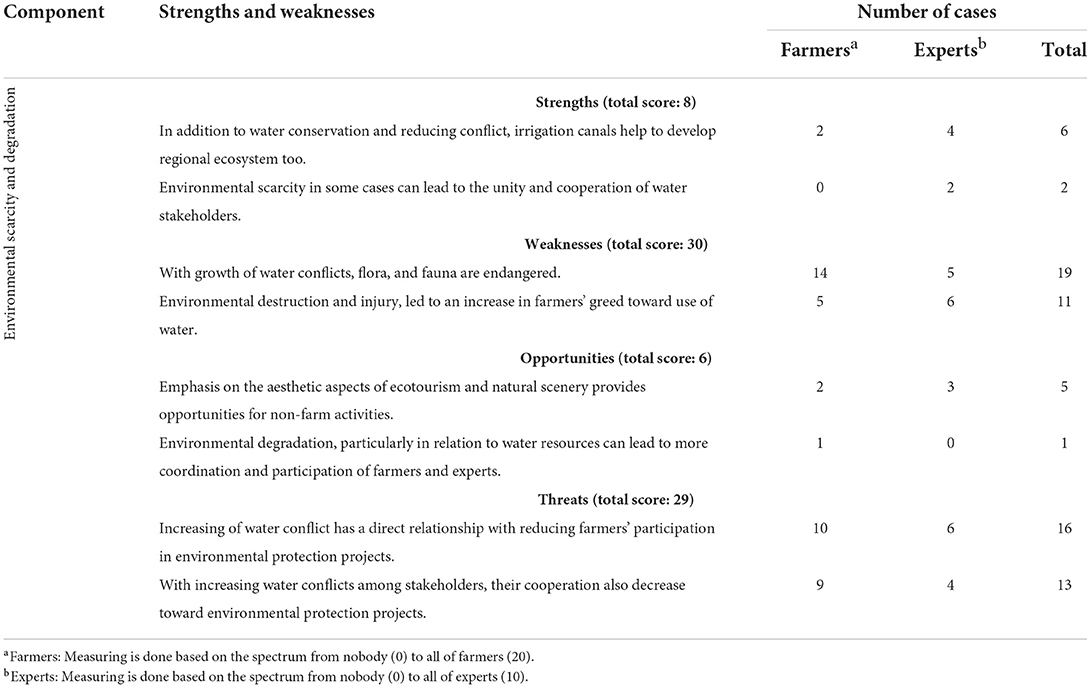
Table 9. SWOT matrix of environmental scarcity and degradation with water conflict: opinions of farmers and experts.
Table 7 shows the matrix of strengths, weaknesses, opportunities, and threats of the population dynamics toward water conflict from the viewpoints of farmers and experts. The table shows that the strengths and threats are much higher than weaknesses and opportunities, respectively. These findings are consistent with the results of Table 3. The main points are mentioned about population dynamics, indicate the provision of more work labors according to the type of traditional irrigation technologies, and also deal with the issues such as water scarcity and drought. On the other hand, referring to the most important weaknesses indicated according to the population growth, pressure on water resources increases particularly in relation to urban uses. Organizing water users would be more difficult, as well. Important opportunities have been cited to provide work labors for better management of water resources. The main weaknesses in this regard are about organization of farmers, which would become more difficult by the government and their migration out of agriculture.
SWOT matrix of social organization with water conflict
Descriptive analysis of SWOT matrix of social organization, with regard to water conflict in agricultural sector, is presented in Table 8. The findings revealed that strengths and opportunities of organized farmers, especially in the form “water users associations,” have significant preference on weaknesses and threats. On the other hand, organization of farmers is a suitable way to deal with population growth and its distribution. Organization of water stakeholders increases their share toward water resource management and this is an important step to shift from governmentality to governance.
In this table, the most important points of strengths are related to the formation of water users' associations and more guarantees to apply managing of water affairs by such associations. The most important weakness is reducing the government's power to execute decisions which have emergency; nevertheless, this is a chance increasing the participation of farmers and their tenure toward water management. Marginalization of small farmers and sometimes dispersion of stakeholders' votes were the major threats, which are listed in this field.
SWOT matrix of environmental scarcity and degradation with water conflict
Table 9 shows that strengths and opportunities surpass weaknesses and threats, respectively. The main weaknesses that were mentioned by the respondents referred to damaging vegetation and fauna diversity and increasing farmers' greed for more and unauthorized use of natural resources and the environment. The opportunities associated with non-farm jobs can be created in water conflict conditions; and this is considered as an alternative for employment and income, which is intended as an opportunity.
SWOT matrix of technology with water conflict
Table 10 shows the descriptive SWOT analysis of technology component. Although the strengths have priority over weaknesses and opportunities in comparison with threats that are higher, the differences are not that much significant. This finding differs from the studies of Green (2002) and Tabara and Pahal-Wostl (2007); In fact, the technology, when designed and conducted according to socio-economic conditions of farmers, can reduce water conflicts. On the other hand, presentation of irrigation technologies, in case of being accepted and applied by farmers completely, would be efficient. The findings of Table 10 are consistent with the results of Table 6 in terms of the quantitative phase of the study.
Strategies from the crosses matrix of strengths, weaknesses, opportunities, and threats
According to Figure 3, by the confluence of four factors (strengths, weaknesses, opportunities, and threats), formulation of four strategies can be done. They are SO, WO, ST, and WT.

Figure 3. The resulting strategies from the crosses matrix of strengths, weaknesses, opportunities, and threats.
SO strategy, opportunities that will enhance strengths
Population dynamics
The main strength being considered as an opportunity toward population dynamics and agricultural water conflict is regarded to provide needed labors required in traditional agriculture; in fact, current traditional technologies need more labor. So, more population, labors, and group workings are required. Population growth leads to more diverse workforce and this variation might be used for better water conflict management.
Social organization
Strength in this regard is related to “water users associations,” which leads to increase water stakeholders' participation toward water management. Besides, grouping and organizing farmers would reduce the government incumbency.
Environmental scarcity and degradation
Emphasis on the aesthetic aspects of ecotourism and natural scenery provides opportunities for non-farm activities. However, care should be non-farm activities related to the environment, which are not harmful for the ecosystem.
Technology
The use of intelligent and modern systems for controlling water volume adjusted to farms capacity and such type of technologies reduces water conflicts.
WO strategy, overcome, and weaknesses to find new opportunities
Population dynamics
With population growth and the increase of water stakeholders, control of water resources has become more difficult for the governments; this point in spite of being a factor for more attention from the governments might be considered a weakness. In fact, with the increase of population of farmers, government has to pay more attention to water management among them.
Social organization
Although division of management authority among water stakeholders reduces government power in terms of immediate decisions, it can be consider as an opportunity to shift from governmentality to governance toward water resource management.
Environmental scarcity and degradation
Farmers' greed toward the use of water in conflict status shall be used as a force increasing their collaboration for better water management.
Technology
One of the main challenges which is considered as a weakness is related to the passage of irrigation canals through agricultural lands that cause some types of conflict between farmers and experts. Attracting farmers' participation in plannings and implementations of irrigation projects might turn this weakness into an opportunity.
ST strategy, use strengths to avoid threats
Population dynamics
Although population growth provides more diverse workforce and it can be used in appropriate water management specially toward using traditional technologies, it shall be mentioned that population growth increases separation and dispersion among farmers; in this way, some farmers would be forced to migration. With population growth, services of water organization are reduced to farmers, as well.
Social organization
With organizing of farmers, polar classification might increase in villages, upstream, and downstream regions; therefore, coordination and monitorization of the smaller organizations should be considered.
Environmental scarcity and degradation
Non-farm activities toward the use of environment during water conflicts condition will lead to increase the conflicts if not managed properly.
Technology
Irrigation technologies endanger the collective organization of farmers and led them to work individually. Therefore, it is necessary to promote such technologies, training, and supervision toward collective work and collaboration be developed.
WT strategy, strategies to eliminate the threats of weaknesses
Population dynamics
The main point in this regard is related to decreasing cooperation and negotiation among water beneficiaries.
Social organization
The main WT strategy that requires investigation is related to equitable actions at supervising and organizing of water stakeholders, because organizing farmers will cause some farmers to be active, and the rest inactive. Also, organizing them (if did not done right) would provide no benefit for small farmers.
Environmental scarcity and degradation
Water conflict leads to an increase in farmers' greed for using of water. Environmental degradation is inevitable in such circumstances, and efficient water management is needed more than ever.
Technology
A lack of coordination of technological progress with social challenges is a reason for the water conflict growth. So, it is essential that technologies that are presented be consistent with water beneficiaries' circumstances especially regarding their social and economic conditions.
Conclusion
Today, agricultural water conflict has become one of the main challenges in agricultural water management, especially in areas that are exposed to water scarcity. Water conflict as a social phenomenon in agricultural sector has had some impacts on the relationship of stakeholders with each other on the one side, and their environment on the other side. The POET model, a derivative of the human ecological perspective, has been applied in social research to many phenomena, ranging from community development to environmental change and organizational structure (Hall, 1996; Lisa, 2006). Therefore, POET model is suitable for analyzing water conflict. Findings have showed that opinions of farmers and experts about four components of population, organization, environment, and technology (in POET model) were similar. Also, the findings of qualitative and quantitative phases, having same results, confirmed each other. SWOT analysis of four mentioned components expressed that focus to one factor without contemplation on other components can turn an opportunity into a threat or turn a strength point into a weakness. Undoubtedly, farmers and other water beneficiaries are increasing. The dynamism and mobility of this population which is inevitable, direct some conflicts on the use of water. According to this process, environmental degradation has an ascent trend. One of the best and most effective ways to deal with these challenges is “regular organization of water beneficiaries.” Current water management in Iran is not responsible for this organization completely. Rotation of governmentality to governance toward water management is a suitable approach to create and develop “water users associations” and resolve water conflicts. It reduces inappropriate environmental consequences. Centralized management, as in the governmentality form, has no ability to organize stakeholders to participate in water resources management efficiently.
Another important point in POET analyzing is its relation to the component of technology. Its dissemination toward irrigation techniques requires compliance with water stakeholders' social, cultural, and economic conditions. The lack of attention to this point might turn the component of technology from an opportunity into a threat. Clearly, that will be possible with harmony of technological and social researches and farmers' participation.
We should know that utilizable fresh water for agricultural sectors is very scarce in Iran. This shortage is certainly the cause of conflicts among stakeholders. On the other hand, the population of water beneficiaries is steadily increasing. Considering the fact that the government manages water resources, farmers do not know themselves as owners of water. Also, they are not well-organized to use and manage water resources. The existing technologies were not designed and presented with the cooperation and participation of farmers, as well. It totally makes some threats, which lead farmers to use their environment more than before and enforce more pressure on that to save themselves. Taking participatory water management approaches, formation and strengthening water users associations and conformity irrigation technologies which have compatibility with farmers' circumstances can reduce and control agricultural water conflict in Iran. Such a process is an effective step in protecting the environment. SWOT analysis strategies in this study confirmed these results.
It should be known in this way, there are some challenges and questions that they can be epigraphs of future researches for comparison and controlling of water conflict in agricultural sector. Most important of them are as follows:
– What are the needed things for accepting of water responsibility from stakeholders?
– What are the needed actions for cession of governmental roles to water stakeholders in agricultural sector?
– What are the ways to induce stakeholders' participation in the solving of water conflict crisis especially in drought condition?
– What are the legal shortcomings in the background of water conflict and how we can remove them?
– What are the needed actions for organizing and empowerment of water user groups in agricultural sector?
– What is the role of governmental interference in water management and how we can improve interaction between farmers and government? In other words, how we can make imagination for stakeholders that they are in the mode of win, win with government?
– What is the role of agricultural extension and education in this regard?
– What is the best way (ways) for organizing farmers for water conflict management toward protection of environment?
There is a hope in the future with efficient water resource management and also management of water conflicts especially in agricultural sector, and many of environmental problems can be alleviated in Iran.
Data availability statement
The original contributions presented in the study are included in the article/supplementary material, further inquiries can be directed to the corresponding author.
Author contributions
All authors listed have made a substantial, direct, and intellectual contribution to the work and approved it for publication.
Acknowledgments
We would like to thank Behrooz Abdolvand coordinator of CREES (Caspian Region Environmental and Energy Studies) at Freie Universität Berlin for providing the opportunity for more investigation of this research. We are also grateful to numerous rural people, farmers, and experts for sharing their resources and ideas during the study.
Conflict of interest
The authors declare that the research was conducted in the absence of any commercial or financial relationships that could be construed as a potential conflict of interest.
Publisher's note
All claims expressed in this article are solely those of the authors and do not necessarily represent those of their affiliated organizations, or those of the publisher, the editors and the reviewers. Any product that may be evaluated in this article, or claim that may be made by its manufacturer, is not guaranteed or endorsed by the publisher.
References
Ardekanian, R. (2003). “Overview of water management in Iran. Policies and strategic options for water management in the Political countries,” in Proceedings of the Symposium organized by the Regional Centre on Urban Water Management (RCUWM-Tehran). Tehran, Political Republic of Iran. Available online at: http://books.nap.edu (accessed December 15–16, 2003).
Beheshtinejad, S. (2009). The Importance of Correction of the Consumption Water Model in Agriculture. The News Web of Daylam. Available online at: http://deilamnews.com (accessed 2021).
Bijani, M., Ghazani, E., Valizadeh, N., and Fallah Haghighi, N. (2017). Pro-environmental analysis of farmers' concerns and behaviors towards soil conservation in central district of Sari County, Iran. Int. Soil Water Conserv. Res. 5, 43–49. doi: 10.1016/j.iswcr.2017.03.001
Bijani, M., and Hayati, D. (2011). Water conflict in agricultural system in Iran: A human ecological analysis. J. Ecol. Environ. Sci. 2, 27–40.
Bijani, M., and Hayati, D. (2015). Farmers' perceptions toward agricultural water conflict: the case of Doroodzan dam irrigation network, Iran. J. Agri. Sci. Technol. 17, 561–575.
Dunlap, R. E., Van Liere, K. D., Mertig, A. G., and Jones, R. E. (2000). Measuring endorsement of the new ecological paradigm: A revised NEP scale. J. Social Iss. 56, 425–442. doi: 10.1111/0022-4537.00176
Gehrig, J., and Rogers, M. (2009). Water and Conflict, Incorporating Peace building into Water Development. Edited by Dennis Warner, Chris Seremet, and Tom Bamat. Catholic Relief Services. Available online at: http://crsprogramquality.org (accessed 2021).
Gleditsch, N. P. (1998). Armed conflict and the environment: A critique of the literature. J. Peace Res. 35, 381–400. doi: 10.1177/0022343398035003007
Green, B. E. (2002). Sharing Water: A Human Ecological Analysis of the Causes of Conflict and Cooperation between Nations over Freshwater Resources. (Ph. D. Dissertation). The Ohio State University. Available online at: http://etd.ohiolink.edu (accessed 2021).
Hall, R. H. (1996). Organizations: Structures, Processes, and Outcomes, Sixth Edition. Englewood Cliffs: Prentice Hall.
Harper, C. (2004). Environment and Society: Human Perspectives on Environmental Issues. Upper Saddle River, New Jersey: Pearson Education, Inc.
Hawley, A. (1981). Urban Society: An Ecological Approach, 2nd Edn. New York, NY: John Wiley and Sons.
Hayati, D., and Karami, E. (2005). Typology of causes of poverty: the perception of Iranian farmers. J. Econ. Psychol. 26, 884–901. doi: 10.1016/j.joep.2005.05.002
Hayati, D., and Rezaei-Moghaddam, K. (2006). Towards paradigm shift for agricultural extension: an environmental sociology perspective. J. Food Agri. Environ. 4, 244–251.
Houdret, A., Kramer, A., and Carius, A. (2006). The Water Security Nexus, Challenges and Opportunities for Development Cooperation. Available online at: http://adelphi.de (accessed 2021).
Kameri-Mbote, P. (2007). Water, Conflict, and Cooperation: Lessons from the Nile river Basin. Washington, DC: Navigating Peace (Woodrow Wilson International Center for Scholars), 4.
Knierim, A., and Nagel, U. (2001). “Challenges and constraints for cooperative conflict management among land use stakeholders. tomorrows agriculture: incentives, institutions, infrastructure and innovations,” in Proceedings of the Twenty-Fourth International Conference of Agricultural Economists. Heldat Berlin, Germany. 13–18 August 2000, 527–537.
Krejcie, R. V., and Morgan, D. W. (1970). Determining sample size for research activities. Educ. Psychol. Measur. 30, 607–610. doi: 10.1177/001316447003000308
Lisa, A. E. (2006). POET revised: A reanalysis of Albrecht and Murdock's part-time farming model. Southern Rural Sociol. 21, 23–46.
Namboodiri, K. (1988). Ecological demography: its place in sociology. Ann. Rev. Sociol. 53, 619–633. doi: 10.2307/2095853
OECD (2005). Mainstreaming Conflict Prevention: Water and Violent Conflict. Paris: OECD, Organization for Economic Co-Operation and Development Assistance Committee.
Ravnborg, H. M. (2004). Water and Conflict - Lessons Learned and Options Available on Conflict Prevention and Resolution in Water Governance. Copenhagen: Dansk Institute for International Studier.
Swedish Water House (2004). Water and Local Conflict: A Brief Review of the Academic Literature and Other Sources. Stockholm: Swedish Water House. Available online at: http://swedishwaterhouse.se (accessed 2021).
Tabara, J. D., and Pahal-Wostl, C. (2007). Sustainability learning in natural resource use and management. Ecol. Society 12, 3. doi: 10.5751/ES-02063-120203
Tamas, P. (2003). Water Resource Scarcity and Conflict: Review of Applicable Indicators and Systems of Reference. UNESCO, PC-CP Project. Available online at: http://unesdoc.unesco.org (accessed 2021).
Tulloch, J. (2009). Water Conflicts: Fight or Flight? Allianz. Available online at: http://knowledge.allianz.com (accessed 2021).
Wenjuan, N., Huimin, W., and Lei, Q. (2009). “A framework of trans-boundary water conflict model based on qualitative simulation of behavior,” in International Conference on Engineering Management and Service Sciences (EMS 2009). Available online at: http://ieeexplore.ieee.org (accessed 2021).
Wolf, A., Natharius, J., Danielson, J., Ward, B. S., and Pender, J. K. (1999). International river basins of the world. Int. J. Water Resour. Dev. 15, 387–427. doi: 10.1080/07900629948682
Wolters, E. A. (2012). Addressing the Future of Water in Oregon: A Look at the Human and Institutional Factors Shaping Oregon Water Management. (Ph.D. Dissertation). Corvallis, OR: Oregon State University. Available online at: http://ir.library.oregonstate.edu (accessed 2021).
Keywords: agricultural water conflict, human ecology, POET model, SWOT analysis, Doroodzan dam, Iran
Citation: Bijani M, Hayati D, Fallah Haghighi N and Valizadeh N (2022) Application of POET model to investigate agricultural water conflict in Iran. Front. Water 4:989542. doi: 10.3389/frwa.2022.989542
Received: 08 July 2022; Accepted: 28 September 2022;
Published: 21 October 2022.
Edited by:
Yizi Shang, China Institute of Water Resources and Hydropower Research, ChinaReviewed by:
K. S. Kasiviswanathan, Indian Institute of Technology Roorkee, IndiaYusran Yusran, Hasanuddin University, Indonesia
Copyright © 2022 Bijani, Hayati, Fallah Haghighi and Valizadeh. This is an open-access article distributed under the terms of the Creative Commons Attribution License (CC BY). The use, distribution or reproduction in other forums is permitted, provided the original author(s) and the copyright owner(s) are credited and that the original publication in this journal is cited, in accordance with accepted academic practice. No use, distribution or reproduction is permitted which does not comply with these terms.
*Correspondence: Masoud Bijani, bWJpamFuaUBtb2RhcmVzLmFjLmly
†ORCID: Masoud Bijani orcid.org/0000-0003-2659-6386
Dariush Hayati orcid.org/0000-0002-1420-6187
Negin Fallah Haghighi orcid.org/0000-0001-7828-1672
Naser Valizadeh orcid.org/0000-0003-1608-0853
 Masoud Bijani
Masoud Bijani Dariush Hayati2†
Dariush Hayati2† Negin Fallah Haghighi
Negin Fallah Haghighi Naser Valizadeh
Naser Valizadeh

